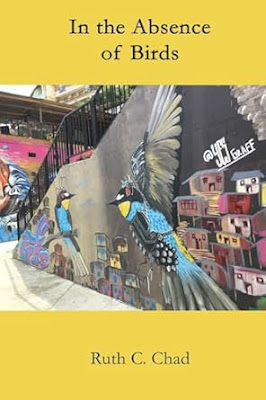The Red Letters
In ancient Rome, feast days were indicated on the calendar by red letters.
To my mind, all poetry and art serves as a reminder that every day we wake together beneath the sun is a red-letter day.
––Steven Ratiner
Red Letter Poem #240
Three Poems from Andrea Cohen
Lucky Strikes
We smoked them so we
could blow smoke rings––
little halos above
coffee cups, above dish
rags and coupons
our mothers clipped
back when the earth
employed them.
Swap Shop
We keep
coming back––
leaving this
mirror for that.
Deadpan. It’s a surprisingly modern word; Webster dates its first appearance in print to1928, referring to the style of acting used in some vaudeville comedy and silent movies (think: the stony stare of a Charlie Chaplin or Buster Keaton, aimed directly toward the audience.) The term quickly spread to sports where certain baseball pitchers and boxers became known for their blank expressions––as if they were about to eviscerate their opponents with no more emotion than swatting a fly. Deadpan is an essential quality in the public persona––and certainly in the literary performance––of Andrea Cohen. Her eighth collection of verse, The Sorrow Apartments (talk about jarring understatement!) was recently published by Four Way Books, where today’s poems were taken. Among her numerous honors are a Guggenheim Fellowship, Glimmer Train's Short Fiction Award, and several fellowships at MacDowell. (When I asked her if there were any recent laurels I should know about for this introduction, she replied: “My laurels? None to speak of.” Bob Newhart would have admired the delivery.) In 2002 Andrea took over from Gail Mazur––the founder of the Blacksmith House poetry series in Cambridge, MA, one of the country’s premier showcases of poetic talent––and has directed it ever since. And yet when she steps to the podium to make her brief introductions, sometimes it takes a moment for the dry wit or the heartfelt praise to have its effect on the audience, delivered in such a quiet, self-effacing manner. Her own poetry––especially her signature short laconic pieces––comes across as being so matter-of-fact, that readers let down their guard (and isn’t that what both comedian and pugilist were counting on?) Before you know it, Andrea has slipped a sly bit of absurdity or a wrenching realization past the mind’s customary defenses. Perhaps she has learned over the years that histrionics only distance the audience, while a demure and measured approach finds the cracks in the mind’s armor.
“Lucky Strikes” is a perfect example; playing off of the cigarette brand name, we imagine a gathering of friends (teenagers, perhaps?) engaging in behavior they might have witnessed in their elders, blowing smoke rings (those nonchalant little halos) “above/ coffee cups, above dish// rags and coupons/ our mothers clipped. . .”. The hominess of the scene is downright calming––leaving aside, for the moment, the cancer warnings on the package which, of course, my lucky parents were not afforded. But what to make of the culminating couplet: “back when the earth/ employed them.” That curious pronoun them––who or what exactly has become obsolete in the earth’s inexorable progress? Does it refer to the coupons––or the mothers themselves who prized their meager rewards? I found the four short lines of “Swap Shop” quietly devastating. The implication is we’ve been trading the furnishings of our lives––perhaps our very self-conceptions––in this psychic swap shop, expecting that one new acquisition will finally make all the difference. By withholding any authorial judgement, we can’t help seeing our reflections in––a harsher light? a more sympathetic one? Finally, there’s the last of today’s trio, and it demonstrates why deadpan is so effective a technique.
Between the Wars
It’s the phrase
we had
after the first
war––so don’t
say blood-
shed invented
nothing.
The preposition of the title refers to the time period between those capital-W World Wars––but it also creates a sense of being wedged-in (as if each couplet formed a tiny vise, gradually tightening.) “It’s the phrase/we had” (what could possibly be menacing about a ‘phrase’?) “after the first /war” (and the lower-case ‘first’ hit me hard, making me realize I’d been lulled into thinking World War 1 and 2 were a finite sequence, instead of an ongoing accounting with no end in sight.) “so don’t// say blood-/shed invented”––so many recombinant ideas teased out by these line breaks: there’s the enjambed command “don’t” stifling comment; the painful rending of “blood-/shed” across two lines (leaving something like an open wound;) and finally that dangling “nothing,” as if it were one half of a couplet waiting for its inevitable mate. And now I’m even wondering whether the shedding of intra-species blood––going all the way back to the prehistory of Neanderthals and those upstart homo sapiens––is the source of the existential nothing that terrifies our sleep today. Andrea delivers these lines in such a subdued manner, unconsciously I’ve dropped my guard––and then: pow! Right to the sweet spot. And the heart is down for the count.
Red Letters 3.0
* If you would like to receive these poems every Friday in your own in-box – or would like to write in with comments or submissions – send correspondence to:
steven.arlingtonlaureate@gmail.com
* To learn more about the origins of the Red Letter Project, check out an essay I wrote for Arrowsmith Magazine:
https://www.arrowsmithpress.com/community-of-voices
and the Boston Area Small Press and Poetry Scene
http://dougholder.blogspot.com
* For updates and announcements about Red Letter projects and poetry readings, please follow me on BlueSky
@stevenratiner.bsky.social
and on Twitter
@StevenRatiner
And coming soon:
a new website to house all the Red Letter archives!


